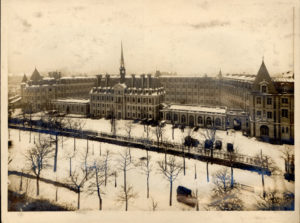Eerie– or inspiring?
When the Smith College Relief Unit arrived in Paris in 1917, one of the first things they did was tour the American Ambulance Hospital at Neuilly, an immense building which had previously been a school, but which had been entirely given over to the care of the wounded, ambulances constantly coming and going.

When the Smith Unit arrived, they were taken to see the pioneering work being done in reconstructive surgery, finding innovative ways to rebuild the faces of men who had been torn to bits by shells. They were shown before and after photos and plaster casts documenting the journey from the ravages of war to something resembling a face.
Some had lost noses, others whole swathes of their face and jaw. Bones had been taken from elsewhere in their body and grafted in, as their faces were painstakingly rebuilt, in some cases from almost nothing.
One woman fainted on the spot.
Others wrote home that they found it simultaneously wonderful and awful, alarming and inspiring.
It was one of their first introductions to the brutal realities of the war, and it made some more determined to persevere– and some more desperate to get out and go home, or to find a safe occupation farther from the front.
If you want to have an idea of what the Smith College Relief Unit was shown, you can find before and after photos of World War I reconstructive surgery in this article from The History Channel. (I’ve included the link rather than the photos so you can decide for yourself whether you want to see or not.)
How would you have reacted?